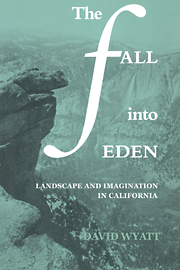Book contents
- Frontmatter
- Contents
- List of illustrations
- Acknowledgments
- Prologue: The mythology of the region
- 1 Spectatorship and abandonment: Dana, Leonard, and Frémont
- 2 Muir and the possession of landscape
- 3 King and catastrophe
- 4 Mary Austin: nature and nurturance
- 5 Norris and the vertical
- 6 Steinbeck's lost gardens
- 7 Chandler, marriage, and “the Great Wrong Place”
- 8 Jeffers, Snyder, and the ended world
- Epilogue: Fictions of space
- Notes
- Bibliography
- Index
6 - Steinbeck's lost gardens
Published online by Cambridge University Press: 18 December 2009
- Frontmatter
- Contents
- List of illustrations
- Acknowledgments
- Prologue: The mythology of the region
- 1 Spectatorship and abandonment: Dana, Leonard, and Frémont
- 2 Muir and the possession of landscape
- 3 King and catastrophe
- 4 Mary Austin: nature and nurturance
- 5 Norris and the vertical
- 6 Steinbeck's lost gardens
- 7 Chandler, marriage, and “the Great Wrong Place”
- 8 Jeffers, Snyder, and the ended world
- Epilogue: Fictions of space
- Notes
- Bibliography
- Index
Summary
Steinbeck's (1902–68) recurring hope was for happiness in a garden. He cultivated many plots along the way–in Los Gatos, Monterey, Sag Harbor, Somerset–but there was one to which he returned. The hope flourished in a cottage in Pacific Grove. The three rooms under the big pine had been the family's summer retreat since John's infancy. “This was the ‘home’ to which Steinbeck kept returning throughout his life.” These are the words of his third wife, the one with whom he would succeed in making the cottage a home, and, in succeeding, surpass the need for it. In times of crisis (the year is 1948) it had been a place to come to:
The thing makes a full circle with 20 years inside it. Amazing, isn't it? And what wonderful years and sad ending ones. I am back in the little house. It hasn't changed and I wonder how much I have. For two days I have been cutting the lower limbs off the pine trees to let some light into the garden so that I can raise some flowers. Lots of red geraniums and fuchsias. The fireplace still burns. I will be painting the house for a long time I guess. And all of it seems good.
Steinbeck was to call one of these big pines the “repository of my destiny,” and it would overarch his experience in ways he could not have foreseen. He was to find and lose this garden many times. The rhythm of repossession and eviction so characteristic of his life was one that also came to shape the energies of his work.
- Type
- Chapter
- Information
- The Fall into EdenLandscape and Imagination in California, pp. 124 - 157Publisher: Cambridge University PressPrint publication year: 1986
- 2
- Cited by

